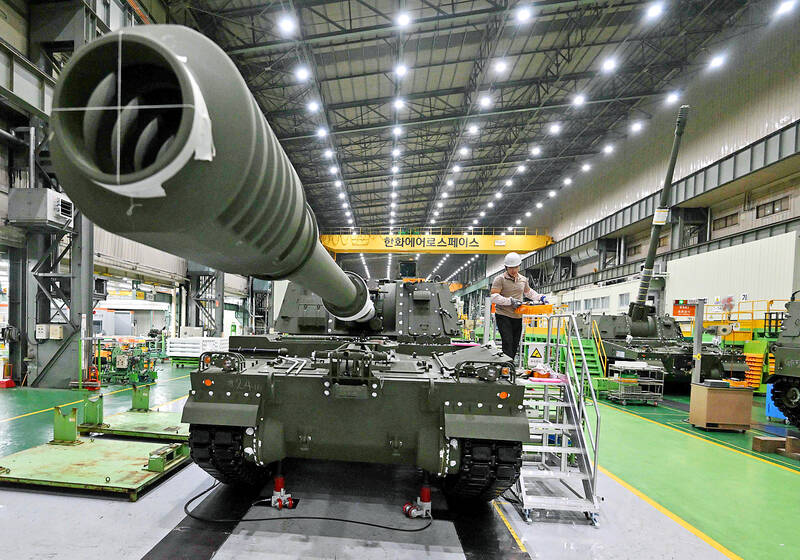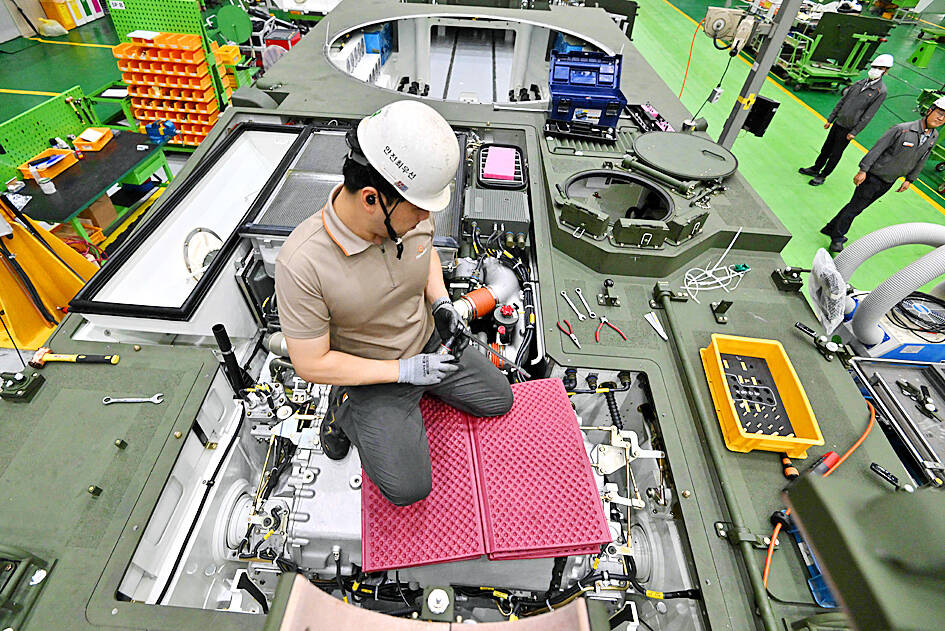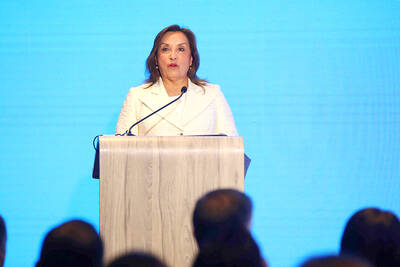At a sprawling South Korean arms factory on Friday, a high-tech production line of robots and super-skilled workers were rapidly churning out weapons that could, eventually, play a role in Ukraine.
Since the Russian invasion last year, the Hanwha Aerospace factory in the southern city of Changwon has expanded production capacity three times, workers told reporters, as South Korea ramps up arms exports while traditional behemoths like the US struggle with production shortages.
Longstanding domestic policy bars Seoul from selling weapons into active conflicts, but even so it signed deals worth US$17.3 billion last year, including a US$12.7 billion agreement with NATO member and key Kyiv ally Poland, for K9 howitzers, K2 tanks and more.

Photo: AFP
And with North Korean leader Kim Jong-un in Russia touring space centers and weapons factories, experts say the South might be forced to review its careful balancing act on the Ukraine war — which Seoul has condemned, even as it resists calls to supply weapons directly to Kyiv.
On the assembly line were rows of Warsaw-bound howitzers, an artillery weapon a bit like a super-mobile cannon.
Hanwha Aerospace, South Korea’s largest defense contractor, is racing to meet delivery targets for the 14-wheeled, 47-tonne K9 howitzers, which have a firing a range of 40km — much longer than a tank, although the K9 needs to be stationary to shoot.

Photo: AFP
Poland ordered 212 K9s last year and Seoul has already delivered 48 of them — a pace “no one else can achieve,” said Lee Kyoung-hun, Hanwha’s production leader.
QUICK DELIVERY
“We are capable of delivering products in the shortest time frame possible,” Lee said, adding that it took between three and four months to build one howitzer from scratch.
Seoul has long harbored ambitions to join the ranks of the world’s top arms exporters — aiming to be the fourth-largest, behind the US, Russia and France — something that is now possible, industry research indicates.
It has already sold artillery shells to Washington — but with a “final user” agreement in place meaning the US would be the military that uses the munitions.
Experts have said this allows the US to then provide their own shells to Kyiv.
‘READY FOR WAR’
South Korea’s arms industry has one key advantage over others globally: It has always been “ready for war,” said Choi Dong-bin, Hanwha Aerospace’s senior vice president.
Hostilities in the 1950 to 1953 Korean War ended with an armistice, not a peace treaty, and Seoul remains technically at war with nuclear-armed Pyongyang.
This gives the country an advantage globally in weapons production, Choi said, as Seoul has the capacity to mass-produce quickly and easily whenever it gets an order.
“The fact that we’re maintaining production line is another boon. At this moment we’re receiving many orders from overseas and we are able to respond quickly to their demands and deliver products in a short period of time,” he said.
Seoul’s weapons are also well tested.
“These are deployed on the ground,” on one of the world’s most heavily fortified borders, Choi said. “Because they are deployed [in South Korea], it has the capacity to perform in any part of the world.”
Heavily sanctioned North Korea lacks Seoul’s high-tech weaponry, but it does have stockpiles of outdated Soviet-era munitions.
Kim met Russian President Vladimir Putin on Wednesday, and experts have warned that the internationally isolated pair might have agreed to a deal involving Pyongyang supplying artillery shells and anti-tank missiles in exchange for satellite technology from Moscow.
Any such deal could change Seoul’s calculations, experts say, as although South Korea has condemned Russia’s invasions of Ukraine, it has resisted calls to step up support to Kyiv, in part as it has long called on Moscow to help manage Kim.
However, if Moscow starts buying weapons from Pyongyang — something that would violate rafts of UN sanctions — it could change the course of the Ukraine war and force Seoul’s hand, said Choi Gi-il, a professor of military studies at Sangji University in Wonju, South Korea.
“If that were to happen, I think it will be more than 50-50 probability that South Korea-manufactured weapons exported to Poland would be deployed to help Ukraine fend off the Russians,” Choi said.
‘GREAT VALUE’
The export of South Korean weaponry, especially the K9 howitzers, would be “of great value to Kyiv,” he said.
“It’s always better to have more howitzers in war and both Russia and Ukraine don’t have enough of them,” he said, adding that Ukraine was mostly using Soviet-era outdated weapons.
“But K9s stand out as among the most recent, overwhelming conventional weapons,” he added. “It will mean so much for Kiev to have them on the frontlines.”

With an approval rating of just two percent, Peruvian President Dina Boluarte might be the world’s most unpopular leader, according to pollsters. Protests greeted her rise to power 29 months ago, and have marked her entire term — joined by assorted scandals, investigations, controversies and a surge in gang violence. The 63-year-old is the target of a dozen probes, including for her alleged failure to declare gifts of luxury jewels and watches, a scandal inevitably dubbed “Rolexgate.” She is also under the microscope for a two-week undeclared absence for nose surgery — which she insists was medical, not cosmetic — and is

CAUTIOUS RECOVERY: While the manufacturing sector returned to growth amid the US-China trade truce, firms remain wary as uncertainty clouds the outlook, the CIER said The local manufacturing sector returned to expansion last month, as the official purchasing managers’ index (PMI) rose 2.1 points to 51.0, driven by a temporary easing in US-China trade tensions, the Chung-Hua Institution for Economic Research (CIER, 中華經濟研究院) said yesterday. The PMI gauges the health of the manufacturing industry, with readings above 50 indicating expansion and those below 50 signaling contraction. “Firms are not as pessimistic as they were in April, but they remain far from optimistic,” CIER president Lien Hsien-ming (連賢明) said at a news conference. The full impact of US tariff decisions is unlikely to become clear until later this month

GROWING CONCERN: Some senior Trump administration officials opposed the UAE expansion over fears that another TSMC project could jeopardize its US investment Taiwan Semiconductor Manufacturing Co (TSMC, 台積電) is evaluating building an advanced production facility in the United Arab Emirates (UAE) and has discussed the possibility with officials in US President Donald Trump’s administration, people familiar with the matter said, in a potentially major bet on the Middle East that would only come to fruition with Washington’s approval. The company has had multiple meetings in the past few months with US Special Envoy to the Middle East Steve Witkoff and officials from MGX, an influential investment vehicle overseen by the UAE president’s brother, the people said. The conversations are a continuation of talks that

CHIP DUTIES: TSMC said it voiced its concerns to Washington about tariffs, telling the US commerce department that it wants ‘fair treatment’ to protect its competitiveness Taiwan Semiconductor Manufacturing Co (TSMC, 台積電) yesterday reiterated robust business prospects for this year as strong artificial intelligence (AI) chip demand from Nvidia Corp and other customers would absorb the impacts of US tariffs. “The impact of tariffs would be indirect, as the custom tax is the importers’ responsibility, not the exporters,” TSMC chairman and chief executive officer C.C. Wei (魏哲家) said at the chipmaker’s annual shareholders’ meeting in Hsinchu City. TSMC’s business could be affected if people become reluctant to buy electronics due to inflated prices, Wei said. In addition, the chipmaker has voiced its concern to the US Department of Commerce